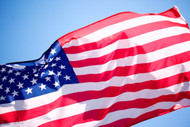On June 14, 1777, the Continental Congress passed an act establishing an official flag for the United States of America. The document for the act stated: “Resolved, that the flag of the United States be thirteen stripes, alternate red and white; that the union be thirteen stars, white in a blue field, representing a new constellation.”
The United States Flag throughout the years represents battles fought by the country’s soldiers, the growth of the country, and the freedom gained for United States citizens.
The Origins of the American Flag
Between 1777 and 1960, Congress passed acts that created the shape, design, and arrangement of the US flag that allowed stars and stripes to be added to reflect each new state.
Today, the US flag consists of 13 stripes, 7 red and 6 six white. The 13 stripes represent the original 13 Colonies while the 50 white stars represent the 50 states of the Union.
We know the meaning of the US flag’s stars and stripes, but what’s the story behind the red, white, and blue? The 7 red stripes symbolize hardiness and valor, the 6 white stripes symbolize purity and innocence, and the blue represents vigilance, perseverance, and justice.
There are only a few locations where the flag is noted to be flown 24/7 in the United States. That includes Fort McHenry in Baltimore, Flag House Square in Baltimore, United States Marine Corps Memorial in Virginia, On the Green in the Town of Lexington, The White House, the United States customs ports of entry, and the Ground of the National Memorial Arch in Valley Forge State Park.
The US Flag Timeline
1776 - The "Grand Union Flag"
The "Grand Union Flag" (also known as the "Continental Colors", "Congress Flag", "Cambridge Flag", and the "First Navy Ensign") is considered to be the first national flag of the United States of America.The Grand Union Flag has 13 red and white stripes, representing the Thirteen Colonies. The upper inner corner features the Union Jack, or flag of the Kingdom of Great Britain that the 13 colonies came from including Connecticut, Delaware, Georgia, Maryland, Massachusetts, New Hampshire, New York, New Jersey, Virginia, North Carolina, Pennsylvania, Rhode Island, and South Carolina.
1777 - Battle of Bennington American Flag
The Battle of Bennington flag is a version of the US flag associated with the American Revolution Battle of Bennington. The '76' in the upper left corner is a reference to the year 1776 when the Declaration of Independence was officially signed.
1777 - 13 stars and 13 stripes American Flag
Francis Hopkinson of New Jersey, was a naval flag designer and a signer of the Declaration of Independence. He designed the American flag with the 13 stars representing the 13 states, and 13 stripes representing the 13 colonies in 1777.
1792 - Betsy Ross US Flag
The Betsy Ross flag is a reconstructed design for the United States flag, from the Flag Act of 1777. These details passed during the American Revolutionary War, and the name stems from the story that Betsy Ross produced this American flag design.
1795 - The "Star-Spangled Banner" American Flag (15 stars, 15 stripes)
.
What does “Star-Spangled” actually mean? This flag is unique from other flags because the stars are tilted in opposing directions every other row. The Star-Spangled Banner, or the Great Garrison Flag, was the American flag that flew over Fort McHenry in Baltimore Harbor during the Battle of Baltimore during the War of 1812. “Garrison Flag” is a U.S. Army term for an extra-large national flag that is flown on Sundays, holidays, and other special occasions
1818 - The United States of America Flag (20 stars, 13 Stripes)
From 1818 – present, the American flag’s design has remained the same with the exception of the addition of a star for each new state that was added on the Fourth of July the year immediately following each state's admission.
The Correct Way to Display Your United States Flag
To show your respect for the American flag and what it symbolizes, it is important that if you choose to fly it, you should follow the U.S. flag code on how it should be displayed.
The US flag should be raised and lowered ceremoniously. The flag should be displayed daily and on all holidays. In inclement weather, the flag should not be flown. Lower your flag when there is bad weather in the forecast to prevent damage.
If your flag is showing signs of wear and tear, it may be time to clean it or purchase a new one based on the severity of the damage. Follow our guide on when to replace your American flag to make sure it stays in good condition to show respect for what you honor and support.
Need a new US flag? Shop a variety of American flags from Collins Flags, including historic flags, military flags, and more.
-

